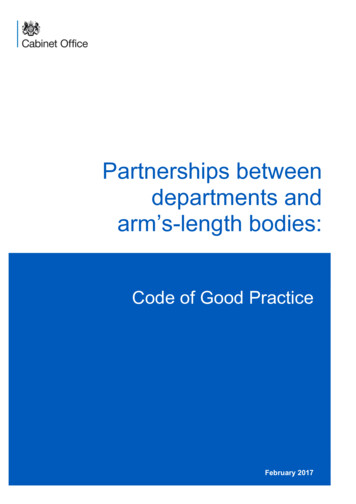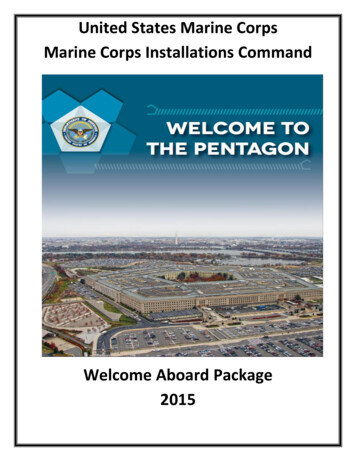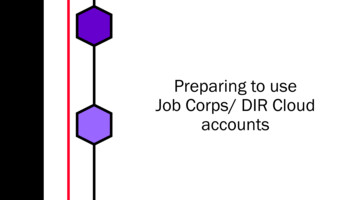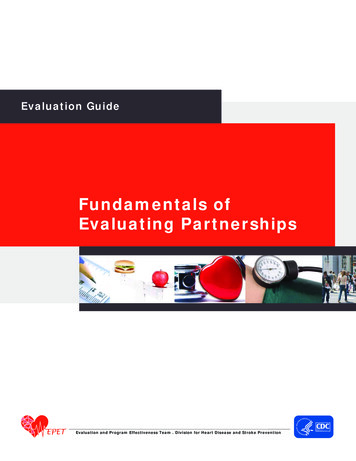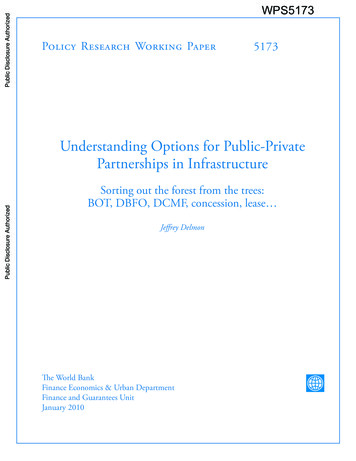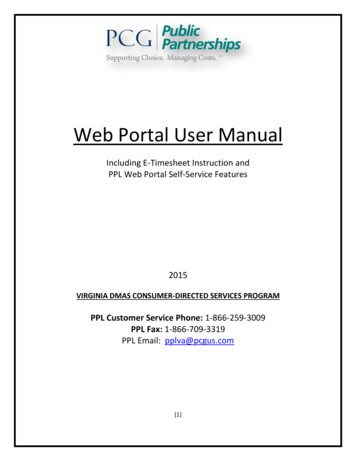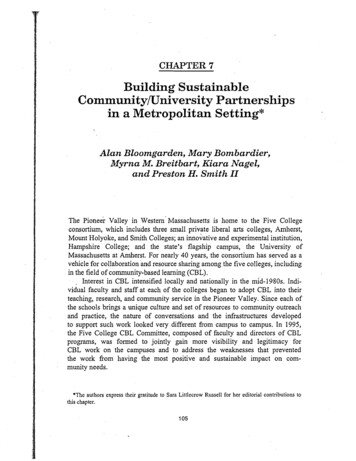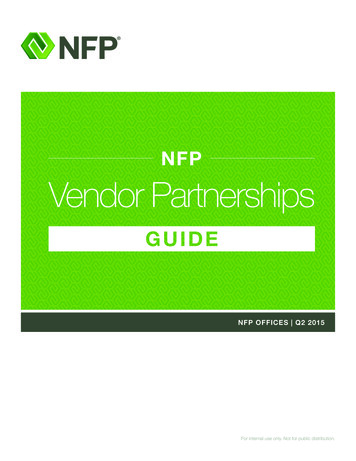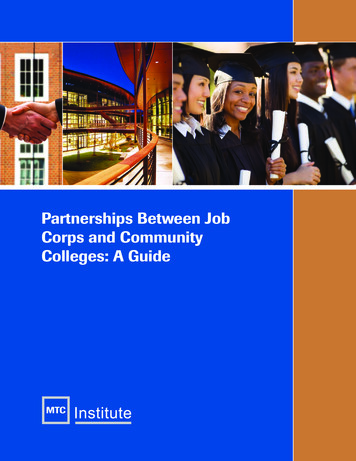
Transcription
Partnerships Between JobCorps and CommunityColleges: A Guide
Partnerships Between JobCorps and CommunityColleges: A Guide
AcknowledgementsThe Institute is grateful to the various Job Corps Center Staff who provided their input including:Thomas Dougher, Programs Director, Red Rock JCCKelly King, Regional Operations Director, Eastern Region, MTC Training GroupDonna Patrick, Programs Director, Springdale JCCAnita Sharp, Center Director, Hawaii JCCBob Starkman, Deputy Center Director, Hawaii JCCJohnny Taylor, Programs Director, Flint Hills JCCUrsula Uhrin, Advanced Center Training (ACT) Coordinator, Keystone JCCWe especially thank the external reviewers who critiqued this document:Elaine Crawley, Youth Liaison Special Projects, Dept. of Community Colleges and Workforce Development,Salem, OregonCharles Flanagan, Director of the Correctional Education Division, and Program Co-Chair, Administration ofJustice Studies for Cochise Community College, Douglas, ArizonaPaul Killpatrick, Ph.D., President, Great Basin College, Elko, Nevada and former Job Corps studentTheir participation has enhanced the value of the information for policy makers, Job Corps Administrators, andCommunity College Administrators.We also extend thanks to the various MTC Executive staff who contributed their understanding and knowledgeto the project. Finally, we recognize the valuable guidance and feedback of this project from Roberts T. Jones,President, MTC Institute as well as comments and observations from MTC Chairman of the Board, Robert Marquardt, Ph.D. and President & CEO, Scott Marquardt whose input helped make this document stronger.Partnerships Between Job Corps and Community Colleges: A GuidePublished by MTC Institute. Copyright November 2007.Principal Author: Stephen MacDonaldComments are appreciated and should be directed to Carl Nink, Executive Director at:MTC Institute500 North Marketplace Drive · P.O. Box 10 · Centerville, UT 84014(801) 693-2870 · Fax: (801) mManagement & Training Corporation (MTC) is an international corporation dedicated to helping people realizetheir learning potential. MTC creates nurturing environments in which education is encouraged and recognized.MTC manages and operates 25 Job Corps centers in 18 states for the U.S. Department of Labor, preparingdisadvantaged youth for meaningful careers. MTC also operates contracted correctional facilities across thecountry with approximately 11,500 beds under contract. In addition, MTC has expanded their education andvocational expertise into the international arena, working in countries such as Iraq, Sudan, Tunisia and Mongolia.The MTC Institute is the research division of MTC, which is dedicated to promoting innovations, exemplarypractices, and projecting trends that are relevant to job training and corrections. The work of the Institute is gearedtowards a broad audience including policy makers, educators, researchers, practitioners, state and federal officials,workforce development entities, correctional agencies and Job Corps centers.
Table of ContentsIntroduction.1Job Corps.1Why Partner.1Principles of Partnerships.2Partners with Shared Missions.2The Benefits of This Partnership.3Beginning a Partnership.3Initiating a Relationship.4Formalizing Relationships with Memorandums of Understanding(MOU),Memorandum of Agreement(MOA), and Articulation Agreements(AA).4Memorandums of Understanding.4Memorandum of Agreement.5Articulation Agreements.5Enhancing and Sustaining Partnerships.6Conclusion.7endnotes.7Appendix A.8Additional institute publications.11MTC Institute
Partnerships between Job Corps andCommunity Colleges: A GuideINTRODUCTIONAn increased number of community colleges and otherorganizations are creating partnerships to provide theeducation and training that the economically and educationally disadvantaged need to succeed. Partnershipsbetween community colleges, non-profits, corporations,foundations, and federal programs such as Job Corpsare steadily growing. The fierce competition that oncetook place between these various organizations, eachseeking to gain the most students or clients, has nowturned into a collaborative effort to educate those whoare seeking new skills but can not readily access PostSecondary Education and Training (PSET).These collaborative efforts are often solidified throughthe use of a formal Memorandum of Understanding(MOU), a less-legally binding Memorandum of Agreement (MOA), or an Articulation Agreement (AA).These types of formal partnerships are developed asthe situation dictates, and are customized to fit the individual needs of each partner. Some partnerships willuse just a MOU or a MOA, others will use just an AA,while others will have several partnerships that requirethe use of both MOU’s and AA’s. For example, in thecourse of developing new partnerships, some partners may be reluctant to commit to a MOU. Instead,they will flourish best under a MOA, something oftenseen as a shared agreement and therefore less contractual. The Job Corps program and its centers use boththe MOU and AA types of agreements in operationsthroughout the US.tual investment of time and resources. A cooperativerelationship between a Job Corps center and nearbycommunity colleges is not only good for the studentsand partners, but an economic mandate for the vitality of the local region and country. In developing orstrengthening partnerships, certain principles shouldbe considered fundamental.Why Partner?Both Job Corps and community colleges can use theiradvantages to overcome mutual obstacles; they arealso attractive to the economically disadvantagedthird of the population because of the open nature oftheir admissions process, training, and overall educational offerings. Job Corps and community collegesprovide a relatively open admissions process, allowing for those who might not make it past a four-yearcollege admissions board to enter and receive aneducation. Furthermore, community colleges and JobCorps provide more substantial remedial educationthan traditional four year colleges, allowing studentsto become better prepared for higher levels of academic courses or training.In many instances Job Corps and Community Colleges provide GED, high school diploma, and collegeprep programs, opening yet another door to potentialBoth Job Corps and community colleges can use their advantages to overcome mutual obstacles; they are also attractive to the economically disadvantaged third of the population becauseof the open nature of their admissions process, training, and overall educational offerings.Job CorpsJob Corps is an integrated, agile, demand-drivenworkforce and education training system. The USDepartment of Labor administers the program to meetthe education and training needs of economicallydisadvantaged youth1 at 122 centers throughout theUnited States2. At a time when most jobs in the futurewill require additional education beyond secondaryschool, and given the scope and nature of the programas well as the population served by Job Corps, partnerships with community colleges can be a wise mu- students. Job Corps and community colleges alsoprovide career and technical training in a variety ofareas for those who do not wish to pursue a full academic program. Job Corps, for example, offers postsecondary education and training (PSET) to peoplewho might be the first in their families to receivefurther education or training; and families who havefirst-time community college enrollees represent 39percent of all student enrollments3. Because of thesesimilarities, both Job Corps and community collegesoffer an environment where anybody can succeed.
Partnerships between Job Corps andCommunity Colleges: A GuidePrinciples of PartnershipsPartnerships are entered into upon different circumstances, some by necessity, and others by desire toprovide the best services. Whatever the reason, partnerships can be distilled to five different principlesthat are true for the overwhelming number of partnerships. They include4: A desire to associate in a partnership. Each memberof a partnership needs to have some desire to cometogether. A mutual hope for youth may serve as thecore catalyst in formation of the partnership. There are mutual interests that bring partnerstogether. The most productive partnerships arethose that bring like-minded people and institutionstogether to address a common area of interests andrelated goals. There exists an ability to work with a partner orpartners. Each partner’s organization or institutionneeds to have the ability or system established towork with partners or the willingness of leadershipto develop the capacity for collaboration. There is something of value that will be offeredto all partners. Each partner needs to gain something from the partnership to make the partnershipworth pursuing. Often this may take the form of anincreased pool of applicants, enhanced retention, orimproved program performance outcomes. There is a belief that a benefit exists in a partnership. Partnerships are based on the idea that a gainwill take place. Each partner needs to feel that theirprogram, institution, or organization will be promoted through the partnership. Perhaps this promotion will be gained through expanded networks ofcolleagues, access to grant funding unavailable tosiloed programs, or increased stature in the community as a positive force for change.Partners with Shared MissionsJob Corps and community colleges provide a relatively open admissions process, giving those whose application might not pass the rigors of a four-year collegeadmissions board’s review the chance to further theireducation. Furthermore, community colleges and JobCorps provide more comprehensive remedial education than traditional four-year colleges, allowing students to become better prepared at their own pace forhigher levels of academic courses or training. In manyinstances, both organizations provide GED, highschool diploma, and college-prep programs, openingyet another door to potential students who wish tocomplete the foundation of their secondary education. Job Corps and community colleges each providespecialty career and technical training in a variety ofareas, often in a complimentary fashion, for those whodo not wish to pursue a full academic program. JobCorps, for example, offers PSET to people who mightbe the first in their families to receive further education or training, while families who have membersthat are first-time community college enrollees represent 39 percent of all student enrollments5. Becauseof these similarities, both Job Corps and communitycolleges offer a supportive environment that embracesdiversity so that most anyone with desire and motivation can benefit.The Flint Hills Job Corps Center has an exemplarypartnership with North Central Kansas Technical College (NCKTC) for students. The studentsare able to complete Training and AchievementRecords (TARs) in construction and health carewhile simultaneously working on an associate’sdegree through NCKTC. In construction, studentswill complete the Construction Craft Laborer TAR,and in health care, they will complete the HealthSupport Services TAR. Both TARs are industryrecognized and standards based.NCKTC will award the students 15 or 16 creditsupon completion of the TAR. The students areconcurrently enrolled in NCKTC but must havecompleted their GED or high school by the timethey complete the last course of career technicalwork to continue on in the associate’s program.When the TAR is complete, students can continuewith NCKTC to complete their associate’s degree.NCKTC has a partnership with Fort Hays StateUniversity, a four-year degree granting institution.In addition to working on TARs while at FlintHills, students will be able to work on theirgeneral education credits toward the associate’sdegree. NCKTC is establishing Flint Hills as asatellite where students can work on NCKTCclasses on-line. Students will be able to work onthe courses during the day and during the eveninghours. The Child Development Center of the SoloParent Program has requested additional fundingfrom social services to provide child care servicesfor solo parents who wish to work on courses inthe evening.MTC Institute
Partnerships between Job Corps andCommunity Colleges: A GuideRecently, the President of NCKTC and two instructors brought a heavy equipment simulator to thecenter. Students were able to sit in a driver’s seat,operate handles, and view their driving on a largescreen. As part of the NCKTC program, their students are required to complete 12 hours of simulation and pass certain checkpoints on the simulatorprior to actual driving the equipment. Flint Hillsstudents had the opportunity to test themselves onthe simulator.Benefits of this PartnershipPartnering allows for the sharing of many different andspecialized, but often scarce, resources. Resources thatmay be shared can range from instruction time, curriculum and materials, and professional developmentopportunities, to the offering of shared programs ofstudy. Whatever the resources, it can be easily said thatpartnering can leverage more efficient and broadeneduse of the resources that both Job Corps and Community Colleges hold in stewardship for young people.Some of the benefits of partnership between Job Corpsand Community College include: Shared management of remedial training. Faculty are able to teach at both community collegeand Job Corps, spreading the cost of each facultymember over both organizations. College Career and Technical Training classes can beoffered at a Job Corps center. Job Corps can house students while they attendCommunity College. Student teachers can perform practicum or providetutoring at the Job Corps site as part of their program requirements. Job Corps teachers can receive the latest training andprofessional development at Community Colleges. The Student Services offices of Community Collegescan help Job Corps students seek employment oncampus or in the local community. Established career centers at Job Corps centers canshift their operations to benefit the students of JobCorps and Community College as well as the surrounding community. Job Corps can provide practical on-site experiencesand opportunities for part-time work for Community College students. Community College students who wish to dropout of college can be counseled by guidance staff toexplore the comprehensive supports of Job Corps,which may in turn lead to the retention of a studentwho might otherwise not complete their educationor training. Increased full time equivalency (FTE) for colleges. Broadened possibilities for receipt of grants or otheradditional funding, as a partnership may better beable to demonstrate through combined efforts thatthey are providing better education and training forJob Corps cohorts. Job Corps students can volunteer for a variety ofprojects and service learning, and may have accessto an expanded social network through student clubofferings at the Community College. The Community College can serve as a satellite JobCorps campus.Beginning a PartnershipPrior to beginning a partnership, it is wise for leadersto meet and first discuss creating the foundation of apartnership. By carefully planning from the partnership’s inception, an open and frank discussion cantake place to see how a partnership could add valueto each program, and be beneficial and or practical forall parties. Any potential barriers to success may beaddressed at this early point so that well-reasoned solutions can be fostered. These initial meetings shouldalso include, but are not limited to, discussions about: What is the core mission of each party and its alignment to the shared mission? What does party each seek to gain from the partnership? What MUST each organization gain from the partnership (e.g. increased enrollments, better retention,increased placements in industry, etc.)? Who will transport students and cover associatedliability? How will funding of work be done in order to becomplementary and yet reduce redundancy of costs? Who are the clientele, and are there any specifictargeted populations to be recruited to the sharedprograms? When will classes be offered to partnering students,and may the schedules be flexible to accommodatethe learning needs of students? Will class cohorts include older and non-traditionalstudents as well as those young people within theJob Corps age range? Where will classes be taught and by whom, and
Partnerships between Job Corps andCommunity Colleges: A Guideare there teacher’s union or association issues to beresolved? What previous courses will be accepted for credit? What additional courses may be considered foracademic credit with slight alterations or enhancements? Are there opportunities for articulated (dual) creditbetween the high school program and the community college?Initiating a RelationshipInitiating a relationship requires effective evaluationand communication of information about the rewardsand potential costs that might be expected as well asunderstanding the organizations’ capacity to fulfillthe expectations. Critical in the development processis the ability to accurately self-assess, disclose, andcommunicate organizational capacity. The tenets of amutually beneficial relationship usually include: Clearly lay out the mission of the organization andthe partnership – a clear sense of identity, purpose,and goals serves to inform all partners about expectations. Identify a central point of contact that is knowledgeable about the organization and capable of providing clear information and access to decision makers. Ability to communicate in an open, honest, andtimely manner – this is particularly true with regardto concerns, resources, and direction.As the partnership develops, parties typically want tosustain the positives derived. This can best be accomplished through a formal agreement.Formalizing Relationships withMemorandums of Understanding(MOU), Memorandum of Agreement(MOA), and Articulation Agreements (AA)Formal agreements se
Justice Studies for Cochise Community College, Douglas, Arizona Paul Killpatrick, Ph.D., President, Great Basin College, Elko, Nevada and former Job Corps student Their participation has enhanced the value of the information for policy makers, Job Corps
